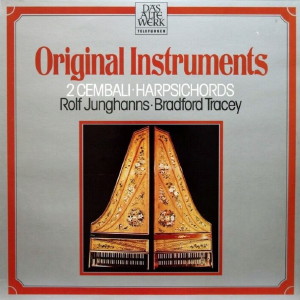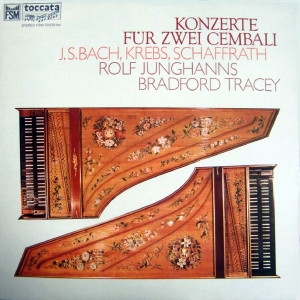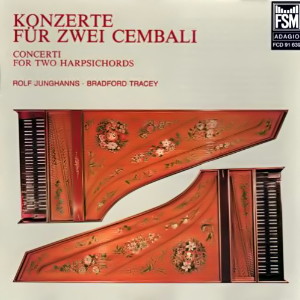 |
1 LP -
Telefunken 6.42633 AP (p) 1981
|
 |
| 1 LP -
Toccata FSM 53 639 (p) 1981 |
 |
| 1 CD -
FSM Adagio FCD 91 639 (c) 1989 |
|
ORIGINALINSTRUMENTE - 2 Cembali
|
|
|
|
|
|
|
|
| Johann Ludwig
Krebs (1713-1780) |
Konzert
a-moll |
|
16' 35" |
|
|
-
Allegro |
6' 33" |
|
A1 |
|
-
Affettuoso |
5' 05" |
|
A2 |
|
-
Allegro |
5' 00" |
|
A3 |
| Christoph
Schaffrath (1709-1763) |
Duetto
a-moll |
|
13' 14" |
|
|
-
Allegro |
2' 46" |
|
A4 |
|
-
Adagio |
4' 48" |
|
A5 |
|
-
Allegro |
5' 40" |
|
A6 |
| Johann Sebastian
Bach (1685-1750) |
Konzert
C-dur, BWV 1061 |
|
19' 05" |
|
|
-
(Allegro) |
8' 02" |
|
B1 |
|
-
Adagio ovvero Largo |
4' 40" |
|
B2 |
|
-
Fuga |
6' 23" |
|
B3 |
|
|
|
|
|
| Rolf JUNGHANNS
& Bradford TRACEY, Cembali |
|
(nach Blanchet,
Paris um 1730, von William Dowd,
Paris; aus der Sammlung
historischer Tasteninstrumente
Fritz Neumeyer, Schloß Bad
Krozingen)
|
|
|
|
|
|
Luogo
e data di registrazione |
|
Schloß
Bad Krozingen, Baden-Württemberg
(Germania) - 1981
|
|
|
Registrazione:
live / studio |
|
studio |
|
|
Recording
Supervision
|
|
Paul
Dery
|
|
|
Edizione LP |
|
TELEFUNKEN
- 6.42633 AP - (1 LP - durata 48'
54") - (p) 1981 - Analogico |
|
|
Originale LP
|
|
TOCCATA
- FSM 53 639 - (1 LP - durata 48'
54") - (p) 1981 - Analogico |
|
|
Prima Edizione CD |
|
FSM
Adagio - FCD 91 639 - (1 CD -
durata 48' 54") - (c) 1989 - AAD
|
|
|
Note |
|
Produced
by Toccata
|
|
|
|
|
The present
view of a concerto
as being a
composition for
one or more solo
instruments and
orchestra was by
no means generally
accepted in the
first half of the
18th century. Thus
Johann Adolf
Scheibe, in his
"Critischer
Musicus"
(1737-1740)
regarded the
criterion of
concertante
writing as being
the competition
between two or
more soloists,
rather than
between an
instrumental solo
and the orchestral
tutti. According
to him concertante
movements were
primarily those
“in which two or
more concerted
parts vie with one
another ... for
they must always
be made to work
and compete with
each other.”
This older
principle of
“concertizing”
had, however,
already been
partially
abandoned by
Johann Ludwig
Krebs in his
Concerto in A
minor for two
harpsichords and
been replaced in
many respects by
the newer
approach; in that
respect its style
is the most
advanced of the
three concertos in
this recording.
While the first
harpsichord
maintains its
position as a solo
instrument
virtually
throughout, the
second harpsichord
is treated as a
continuo
instrument for
long stretches at
a time and only
occasionally
attains equal
status with the
first. The works
of Krebs, who was
one of Johann
Sebastian Bach’s
favourite pupils,
occupy the middle
ground between
those of the
master and his
sons. Although the
three movements of
the Concerto in A
minor neither
display the
motivic tension or
structure of the
Cantor of St.
Thomas’s, nor
emulate the
intensive
expressiveness of
Carl Philipp
Emanuel Bach’s
empfindsam style,
they are imbued
with an al fresco
quality and
freshness.
In Christoph
Schaffrath’s duet
for two
harpsichords in A
minor, the two
instruments play
together as
equals. This still
unpublished little
work by the court
composer of
Frederick the
Great is as well
constructed as it
is attractive.
Only the two
keyboard parts of
Johann Sebastian
Bach’s Concerto in
C for two
harpsichords (BWV
1061) written in
Leipzig, probably
between 1727 and
1730, are in his
own hand. The
four-part
accompaniment for
string orchestra,
which is
traditionally
played with them,
exists only in
copies written out
long after his
death. From this
one cannot but
surmise that the
accompaniment was
added later in
order to comply
with newer
conceptions of the
requirements for a
concerto. The
orchestral writing
is so inadequate
and lacking in
substance that it
amply confirms the
suspicions aroused
by the
circumstances in
which it has been
handed down.
Insofar as the
strings are ever
given a chance,
they almost always
play colla parte
with the
harpsichords,
which are playing
a duet on their
own; occasionally
they reinforce an
already existing
effect in the
interplay of solo
and tutti, but
they never develop
a life of their
own.
The present
recording takes
account of these
observations and
dispenses with the
orchestral
accompaniment
altogether, since
it would only
impede a
convincing
interpretation of
this magnificent
work.
(Translation:
Lindsay Craig)
|
|
|

